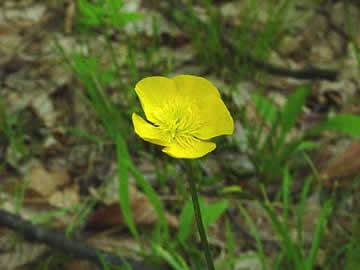
Without competition, the plant can form dense carpets. In addition, bur buttercup often forms associations with soil fungi that enable it to take up nutrients very efficiently, allowing it to grow in poor quality soils. Some common plants that are native to the park include aspen, Ponderosa pine, sagebrush, desert mahogany, Utah juniper, gambel oak and single-leaf. Bur buttercup (Ceratocephala testiculata) is an early spring flowering, low-growing winter annual that usually flowers once temperatures reach the mid-40s to 50☏, setting seed by the first part of May.The plants are quite small, usually reaching no more than an inch or two in height. The plant is very adaptable, and will tolerate moist to very dry conditions. Some common plants that are native to the park include the Common Hornwort, Fern-leaf Desert Parsley, Douglas Fir, Bur Buttercup, and the Leopard Lily are also widely found in the region. The lightweight burs are also easily picked up and carried by water, and are widely distributed. The spiny burs that house the seeds readily cling to shoes, clothing and animal fur. across their bases are petiole-like and undivided, after which. Both the basal leaves and pedicels of the flowers originate from the crown of the plant there are no stems. Each bur contains 5-80 hard, dry seeds.īur buttercup reproduces from seed. Bur Buttercup (Ranunculus testiculatus) Description: This dwarf plant is a winter annual about 2-8 cm. Flowers give rise to oval-shaped, spiny burs that are 1/2 - 3/4 inch long. The tiny, bright yellow, five-petalled flowers are cupped by five egg-shaped sepals. Flowers are borne singly at the tips of leafless stalks, which extend above the leaves. Leaves are all attached at the base of the plant, and many bear a resemblance to antlers, being parted into three distinct, narrow segments, which are themselves often two, three or four-lobed. The light green leaves, which are covered with short, white hairs, grow 1-4 inches long. By early summer, the entire plant dries out and turns brown and brittle.Ī low-growing summer annual, ranging from 1/2 inch to 5 inches in height. The plant blooms within 3 weeks of emergence, and the flowers develop into spiny burs. IMPORTANT: Visit Home and Garden Fact Sheets for more information on using pesticides.Bur buttercup seeds germinate in early spring, when temperatures reach about 41☏, and seedlings emerge soon thereafter.
#Bur buttercup plant skin#
SPECIAL INFORMATION: The sap of creeping buttercup can irritate the skin and mucous membranes. Ceratocephala orthoceras, Ranunculus testiculatus) is a flowering plant that is native to Eurasia. Tall buttercup normally does not root at the nodes.

The lower leaves are divided into 3 to 5 deeply cut segments, while upper leaves are reduced to narrow straplike segments. acris) is similar to creeping buttercup, but often reaches heights of 3 feet. Each seed is about 1/8 inch long and has a short, backward-curving beak.

Seeds are borne in dense, bur-like clusters at the ends of stems. The flowers have five (sometimes up to ten) glossy yellow petals and a cluster of yellow stamens in the center. Flowers are borne on erect stems above the foliage. Other common names for this species include little bur curveseed butterwort and gesticulate buttercup. It produces small yellow flowers in spring. Bur buttercup (Ceratocephala orthoceras) is an annual wildflower that’s indigenous to Eurasia and introduced in North America. Leaves are typically dark green but may have lighter spots. Bur buttercup (Ceratocephala orthoceras). The leaf blade is divided or deeply lobed into three broadly toothed segments. Leaves are also hairy, with long petioles. The stems are hairy and root at the nodes when they contact the soil. Creeping buttercup is a creeping perennial plant that is usually fairly low-growing.


 0 kommentar(er)
0 kommentar(er)
